The best tasting Italian pizza dough recipe with minimal hands-on prep. This super easy no knead pizza dough is also quick-rise so you can bite into crispy, chewy homemade pizza in no time!
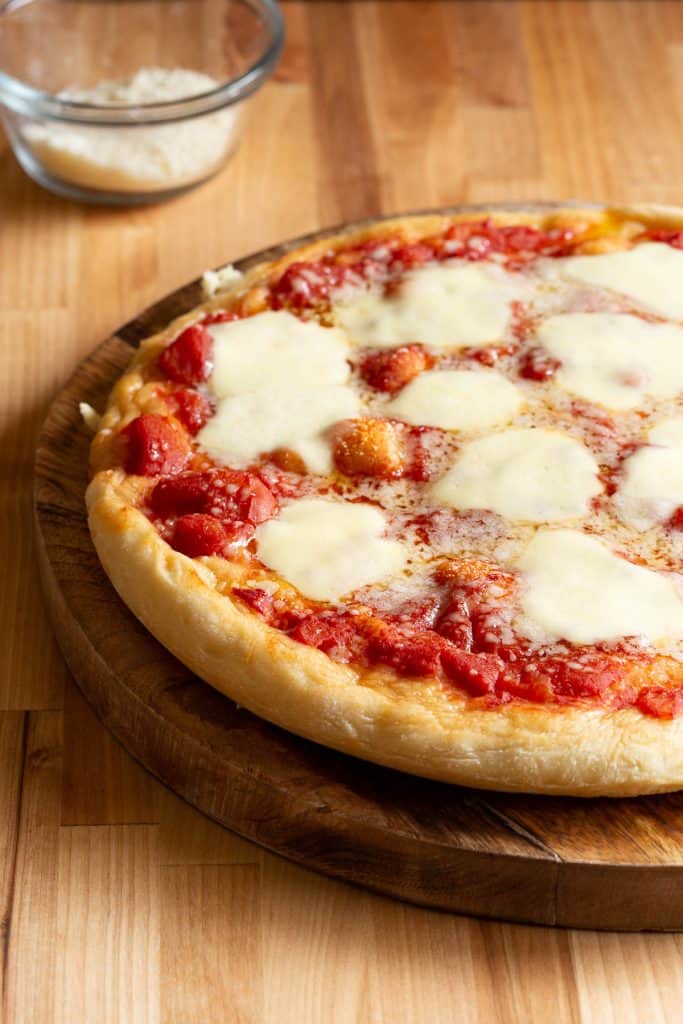
In This Post You’ll Learn
Why We Love This
This is the best Italian pizza dough recipe for homemade pizza with a light fluffy base and crispy crust! Even better, it’s also a no knead pizza dough that’s also quick rise (just 5 hours instead of overnight).
We’ve made this recipe about as hands off as you can get – and if you’re using a stand mixer – even more so. Just start your dough by lunch, proof it during the afternoon, and it’ll be ready for dinner!
Homemade pizza dough tastes so much better than store bought dough or pre-made pizza bases. Just 5 ingredients you’re almost guaranteed to have in your pantry!
Related: Italian Fried Pizza / Homemade Pasta Sauce
Is this a real Neapolitan pizza dough recipe?
We first learned this recipe during our wanders through Naples, Italy, which is renowned as the ancestral home of pizza.
Those familiar with traditional Neapolitan pizza will note our recipe is not a copycat of the official Neapolitan pizza recipe, which has many strict rules and regulations.
Rather, our rustic version is the one taught to us by our Italian mamma Rita during our homestay at her apartment in Naples. One major difference is she includes olive oil in her dough, which helps create a stretchier dough that is crispier once cooked.
According to Rita, it’s the ‘original and the best’ way to make make pizza dough at home!
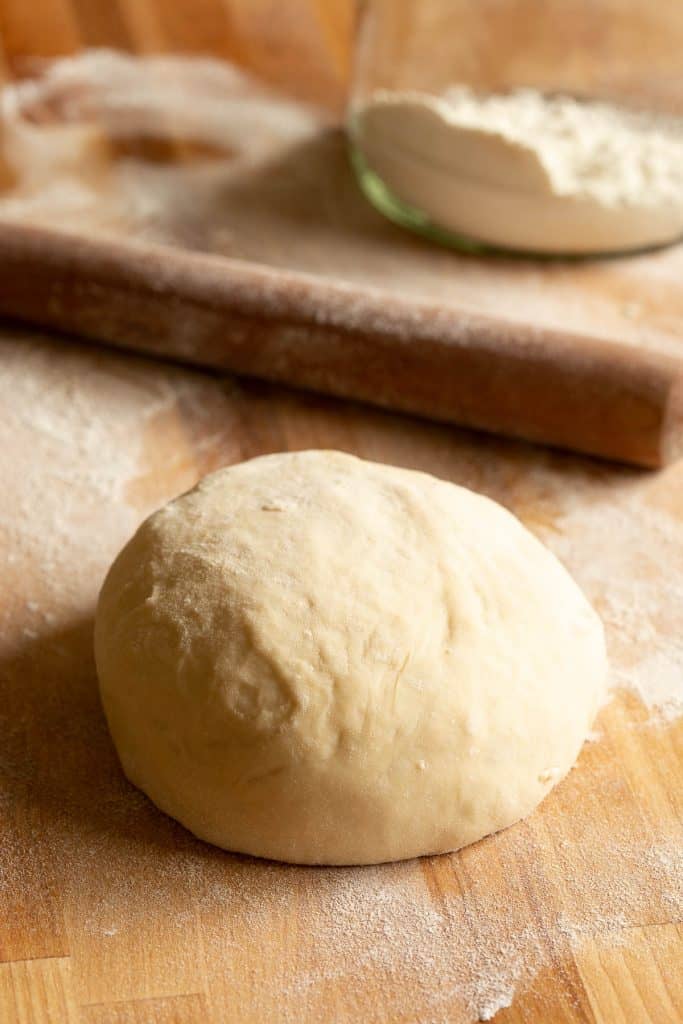
What is Italian Pizza Dough?
This Italian pizza dough recipe starts with a simple base of flour, yeast, olive oil, salt and cold water. It’s similar to bread dough, but with the addition of oil to make it stretchy and help it retain moisture while baking.
Like anything truly worth doing, this process does take time, but thankfully only around 15 minutes of actual hands-on prep. The rest is simply waiting for the dough to rise!
What You’ll Need
- Flour – Caputo’s 00 Flour is the best choice according to Rita, however you can use any kind of pizza flour, baker’s flour, bread flour or all purpose flour as an easy substitute with great results.
- Yeast – We use active dry yeast which doesn’t require warm water to rise. You’ll find this at most supermarkets.
- Cold Water – The secret to allowing extra delicious flavours to develop as the pizza dough proofs.
- Olive Oil – For the best flavour use high quality extra-virgin olive oil. This adds flavour and makes the dough easier to stretch without creating any holes. You won’t find this in any official Neapolitan pizza dough recipe, but it’s more commonly used in Italian households for homemade pizza dough. If you prefer not to use it, just leave it out.
- Salt – Along with flavouring the dough, salt helps to tighten the gluten structure and strengthen the dough.
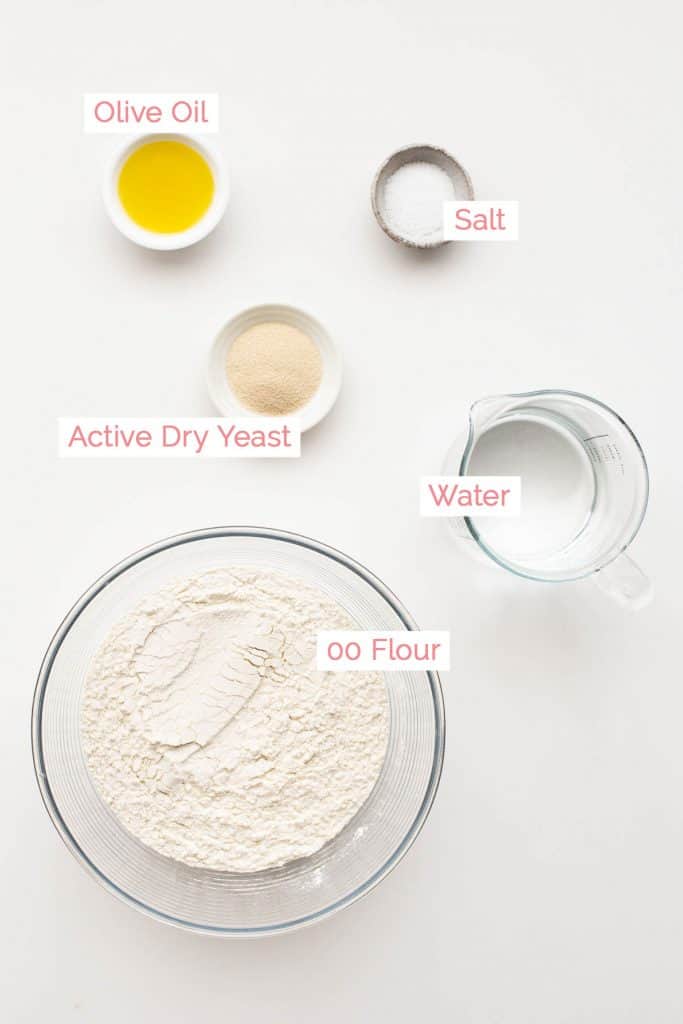
How to Make Italian Pizza Dough
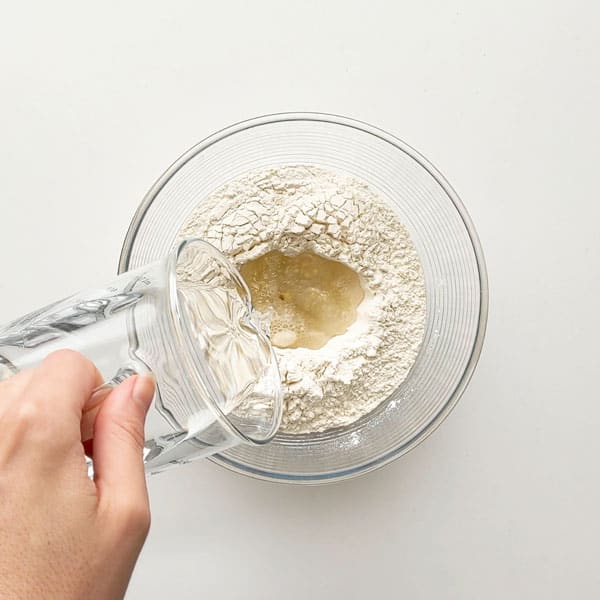
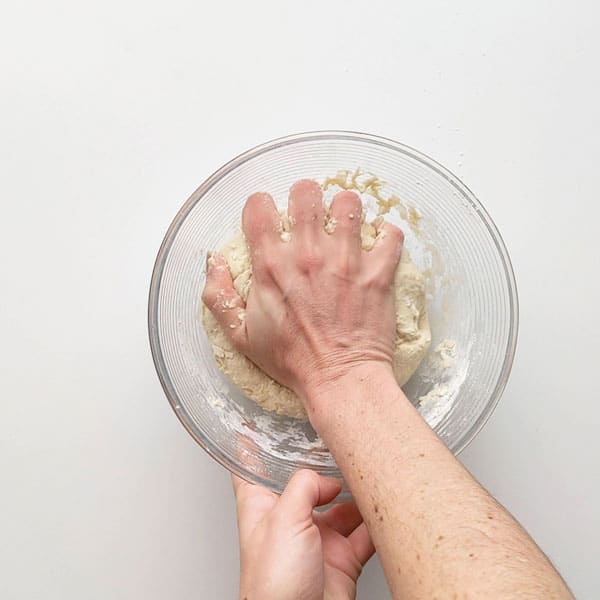
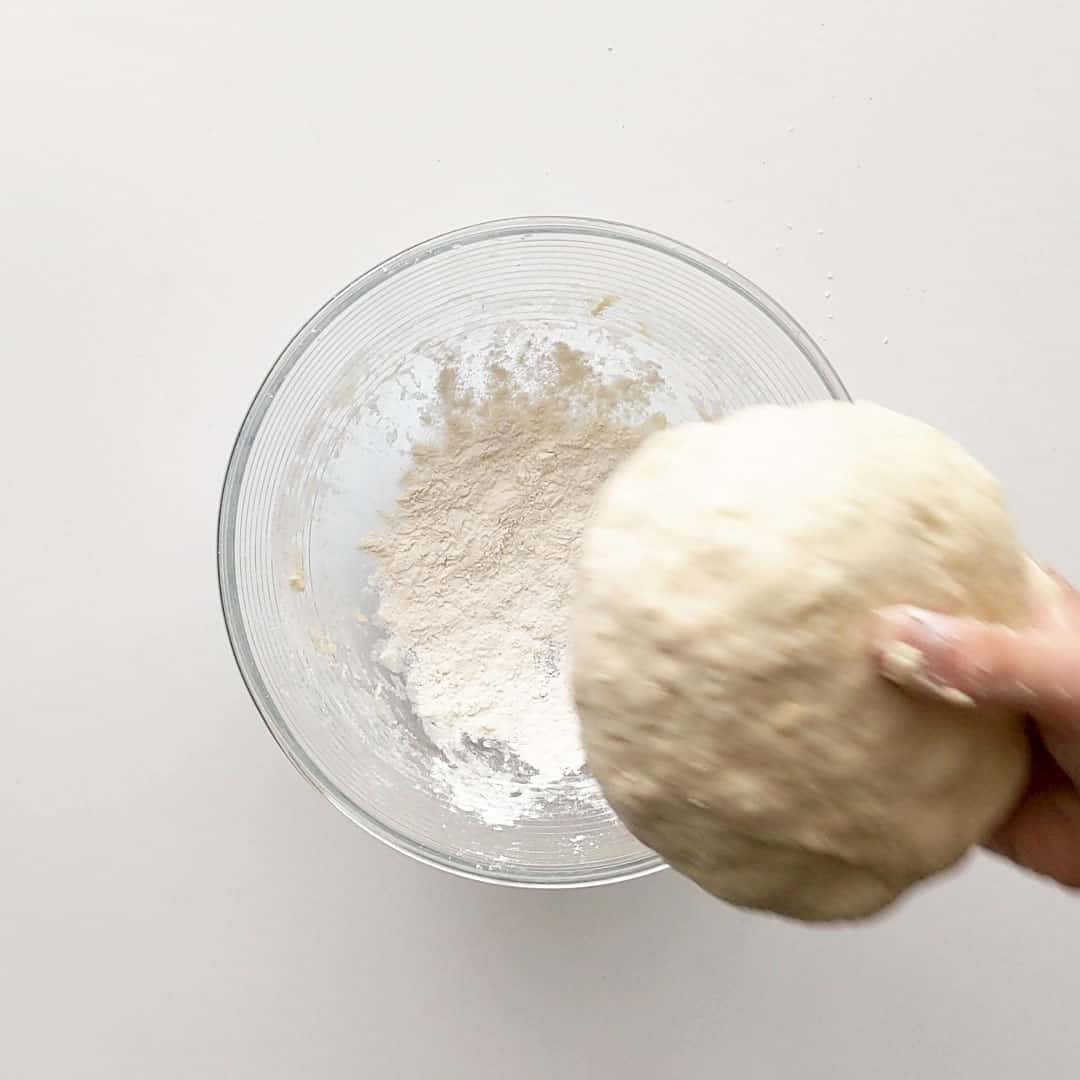
First, gather your ingredients: See recipe card below for measurements.
Prepare the dough:
- Add flour into a large mixing bowl. Make a well in the centre, then add the salt, active dry yeast, olive oil and water.
- Use your hands to mix the flour in large circles. Combine just enough until you have created a pillow of dough in the centre of the bowl and there’s no remaining flour. This should take a couple of minutes. Tip: You can freeze the dough here if you’re making a batch to cook in advance to cook another time.
- Lift the dough and add extra flour underneath to prevent the dough from sticking while resting. Score an ‘X’ shape on the top of the dough. Cover with a towel and rest to proof for 3 hours.
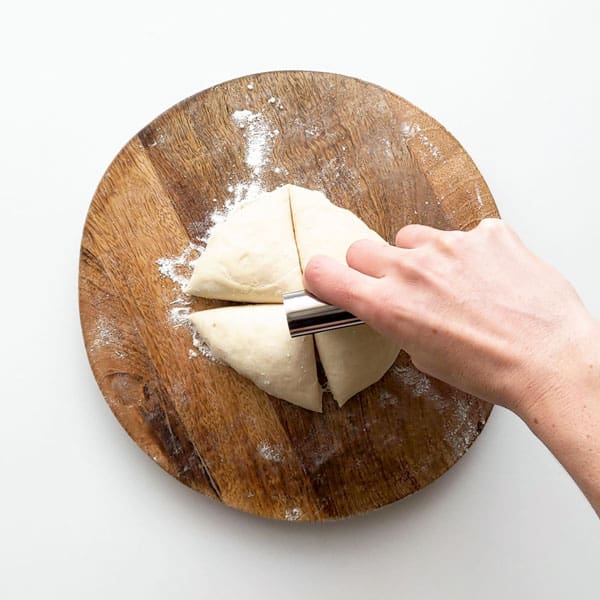
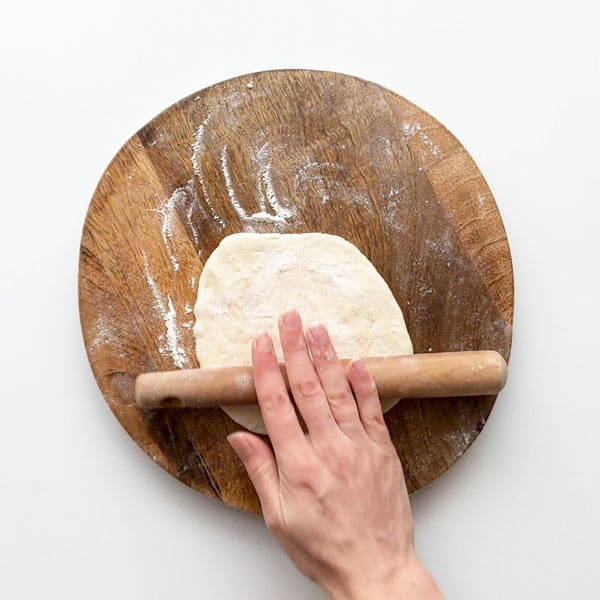
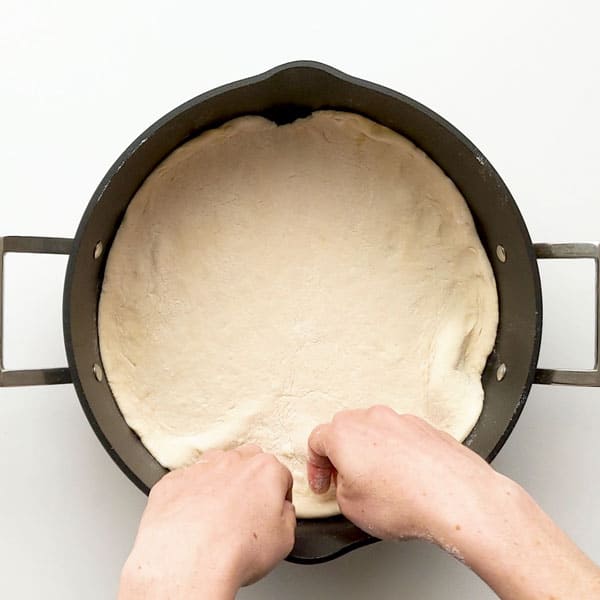
Roll out the dough:
- After the dough has risen, spread plenty of flour onto your rolling surface and rolling pin. Divide the dough into the number of portions you desire. (Ie you could make 2-3 large pizza bases or 8 smaller bases with this amount of dough.)
- Roll the dough portions out into circular bases, using your fingers to stretch out into shape. Don’t worry if the dough is quite thin at this stage, it will continue to rise until it’s time to cook.
- Spread a thin layer of olive oil over each pizza tray (aluminium trays work best for an extra crispy base). Place the dough on the trays and push out to the rim to cover the pan. Be sure to press gently at this stage so as not to push out too much air. Cover and rest again for around 1-2 hours.
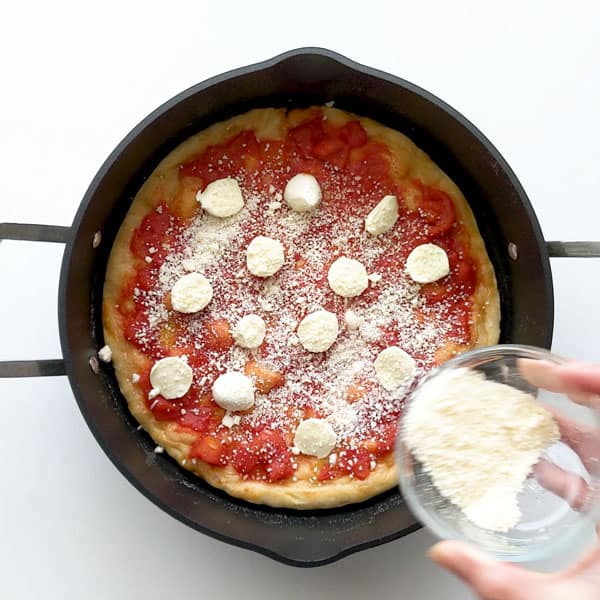
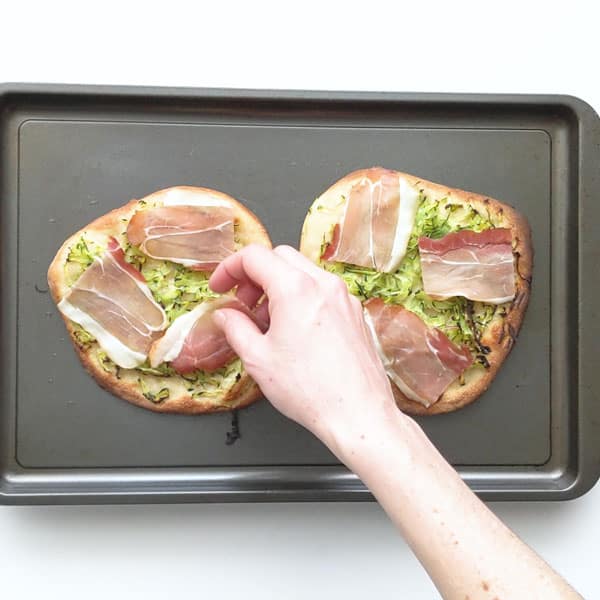
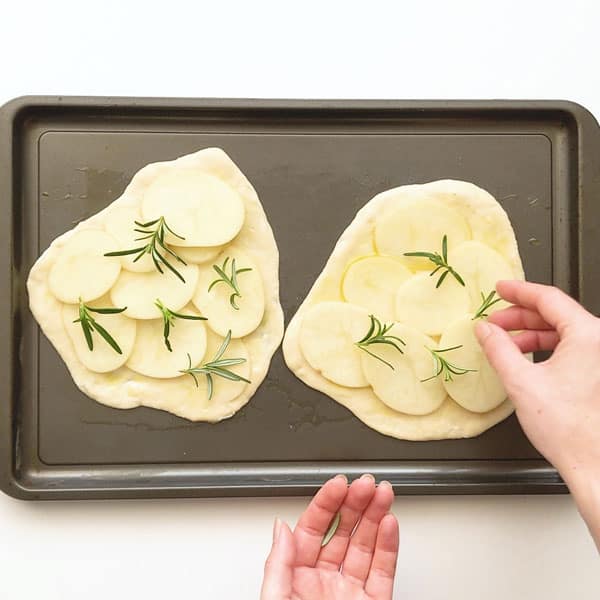
Cooking the pizza + Italian pizza topping ideas:
- Preheat the oven to 250˚C / 480˚F.
- Prepare your pizza toppings, but don’t add the cheese yet!
For Margherita: Top pizza bases with crushed tomatoes or passata (or your favourite pizza sauce) and drizzle with olive oil.
For Zucchini & Prosciutto: Layer pizza bases with grated zucchini only (not the prosciutto yet) and drizzle with olive oil.
For Potato & Rosemary: Drizzle pizza bases with olive oil and layer with thin slices of potato. Top with fresh rosemary and season with salt and pepper. - Bake in the oven for 10 minutes or so until the first topping layer has cooked through nicely. The dough should be just starting to brown at this stage.
- Take out of the oven and sprinkle each pizza with Parmesan cheese and small chunks of mozzarella cheese. Add the prosciutto to the zucchini pizza(s).
- Place pizzas back in the oven and cook for another 5-10 minutes or so until the cheese has melted and the bases are nice and crispy.
Timing the Dough for a 6:00pm Dinner:
- 12:45pm – 1pm: PREP – Start dough.
- 1pm – 4pm: 1ST RISE – Cover, allow the dough to rise in a warm location.
- 4pm – 4:15pm: PREP – Roll out your pizza bases.
- 4:15pm – 5:15pm: 2ND RISE – Add pizza bases to trays, cover again and leave out on the counter to rise for one more hour.
- 5:15 – 5:45pm: PRE-HEAT OVEN – Turn on the oven and add toppings to pizza.
- 5:45pm – 5:55pm: COOK – Get those pizzas in the oven!
- 5:55pm – 6pm: ADD – Take out your pizzas and add your final layer of cheese and meat toppings. Cook for 5 more minutes or until cheese is melted.
- SERVE!
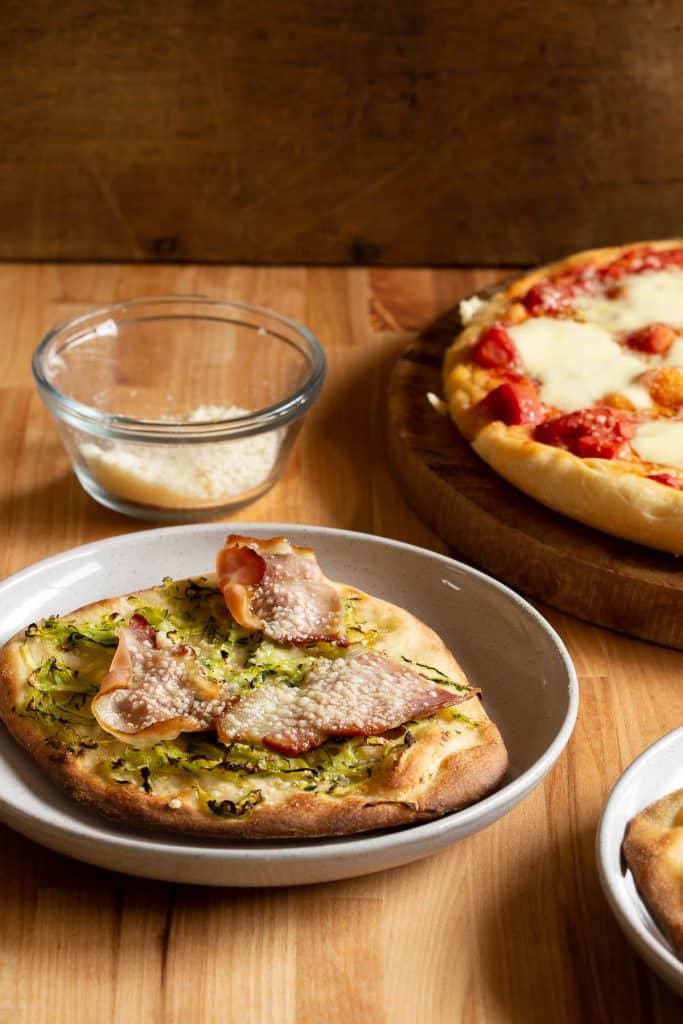
Wandercook’s Tips
- Sticky Dough – If the dough mixture is too sticky, sprinkle more flour to the outside of the dough. You can also do this to help remove sticky dough from your fingers.
- Portions – You can use this dough to make large pizzas, small mini pizzas or pizza fritta (fried pizzas). Just portion out to the sizes you like.
- Rising the Dough – Keep the dough covered in a warm area. If it’s a cold day, pop your oven on its lowest setting or ‘Keep Warm’ setting for 5 minutes to warm the oven. Then switch it off and pop the covered dough in with the oven door shut. We don’t use plastic wrap since we prefer to avoid waste where possible, and find a kitchen towel is enough.
- Storing in Fridge – Once risen, you can leave the dough in the refrigerator overnight in an airtight container. Take it out to rest on your kitchen counter an hour to come up to temperature before using . Cold air slows down the dough rising significantly. If storing in the fridge, use within a few days or freeze immediately after mixing.
- Batch Cook – If you’re entertaining and want to make extra pizza bases, you can easily double the recipe and follow the same steps.
- Aluminium Trays – Aluminium trays are awesome for cooking pizza! Not only are they lightweight, they’re also super thin and transfer heat perfectly for crispy and delicious pizza crusts.
- Cutting the Pizza – You can use a regular knife, a pizza wheel or slice it the traditional Naples way – with kitchen scissors!
FAQs
Yes, you can freeze the dough straight after you’ve mixed the ingredients but BEFORE allowing it to rise. Portion it out into how many pizzas you’d like and freeze separately in airtight containers to stop the dough portions sticking together.
To thaw, pop the dough portions out on the counter for 2 hours to bring up to room temperature. If it hasn’t risen as it’s thawed, let it sit for another 1 – 2 hours.
You can definitely use a stand mixer here. Place all your ingredients in the mixing bowl and attach the dough hook. Pop your mixer on low speed to medium speed – around 3 or 4 – and allow the dough to form over a few minutes. If it’s sticking to the bowl, sprinkle with extra flour.
Once dough has incorporated, take out the hook and form a ball with the dough and continue with the recipe.
Check your active dry yeast is still in date and that it was stored in a cool and sealed environment. If it gets too old or hot, this can kill the yeast and make it unusable.
If it’s risen a little, but not doubled, you may need more time and patience – especially in a cooler climate. Just give the dough more time to rise or move it to a warmer area such as your oven (warm it up on its lowest setting for 5 minutes before).
Actually that’s a myth that’s been proved incorrect. It’s had no effect on our baking and our dough always rises fine as you can see in our recipe video.
Variations
- Cooking Methods – We’ve used pizza pans, pizza stones, baking sheets, aluminium trays, Dutch ovens, a Remoska multi-cooker and flat bottomed pans for this recipe. You can also use a cast iron skillet! If using a pizza stone, it’s best to preheat it in the oven first for extra crispy bases.
- Add Flavour – Try it with onion powder, garlic powder, fresh or dried herbs (oregano, basil, thyme or an Italian seasoning mix) either sprinkled over your toppings, or mixed into the dough before rising.
- Other Uses for the Dough – Use it to make calzone (turnover pizza), focaccia, or grissini (Italian bread sticks).
- Other Toppings – Go nuts with all your favourite toppings, such as capsicum / bell pepper, chopped onions, fresh garlic, mushrooms, olives, you name it!
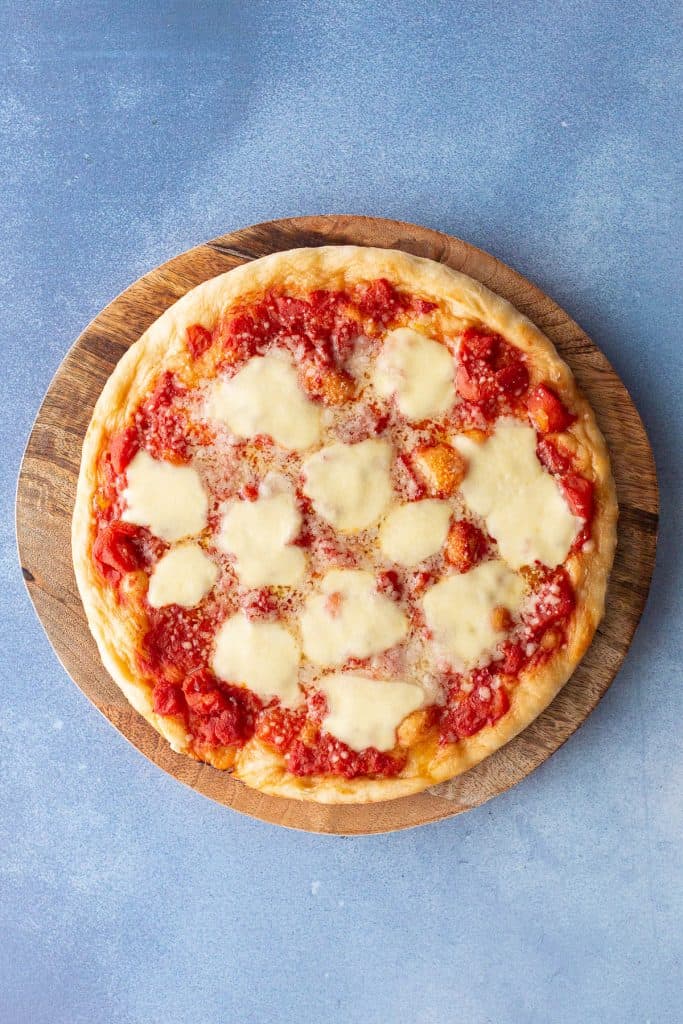
Try these amazing recipes next:
- Pizza Fritta – Italian Fried Pizza – Pizza in 10 minutes? Yes please!
- Vietnamese Pizza (Bánh Tráng Nướng) – A delicious street-food snack you can make at home.
- Napoli Sauce with Pasta – Quick and easy dinner recipe.
- Creamy Sausage Pasta – Extra delicious with Italian sausages.
- Gochujang Pasta – Super simple and deliciously spicy!
★ Did you make this recipe? Please leave a comment and star rating below!
Equipment
Ingredients
For the Dough
- 400 g ‘00’ flour (3 cups) or baker's flour / all purpose flour PLUS 1/4 cup for rolling the bases out
- 250 ml cold water (1 cup)
- 20 ml olive oil (4 tsp) PLUS 1-2 tbsp oil per pizza tray
- 10 g salt (2 tsp)
- 9 g dried yeast (3 tsp) or 'brewer's yeast'
For the Toppings – we used the following as 'standard' topping ingredients on each of our pizzas.
- pinch salt and pepper
- olive oil dash
- parmesan cheese sprinkle
- mozzarella cut into small chunks
Margherita
- tomatoes crushed or diced from a tin
Zucchini & Prosciutto Pizza
- 2 zucchini grated
- 2 slices prosciutto roughly chopped, or bacon
Instructions
Prepare the dough:
- Add flour into a large mixing bowl. Make a well in the centre, then add the salt, active dry yeast, olive oil and water.400 g ‘00’ flour, 250 ml cold water, 20 ml olive oil, 10 g salt, 9 g dried yeast
- Use your hands to mix the flour in large circles. Combine just enough until you have created a pillow of dough in the centre of the bowl and there’s no remaining flour. This should take a couple of minutes. Tip: You can freeze the dough here if you’re making a batch to cook later.
- Lift the dough and add extra flour underneath to prevent the dough from sticking while resting. Score an ‘X’ shape on the top of the dough. Cover with a towel and rest to proof for 3 hours.
Roll out the dough:
- After the dough has risen, spread plenty of flour onto your rolling surface and rolling pin. Divide the dough into the number of portions you desire. (Ie you could make 2-3 large pizza bases or 8 smaller bases with this amount of dough.)
- Roll the dough portions out into circular bases, using your fingers if needed to stretch out into shape. Don’t worry if the dough is quite thin at this stage, it will continue to rise until it’s time to cook.
- Spread a thin layer of olive oil over each pizza tray (aluminium trays work best for an extra crispy base). Place the dough on the trays and push out to the rim to cover the pan. Be sure to press gently at this stage so as not to push out too much air. Cover and rest again for around 1-2 hours.
For the toppings:
- Preheat the oven to 250°C / 480°F.
- Prepare your pizza toppings, but don’t add the cheese yet!
- For Margherita: Top pizza bases with crushed tomatoes or passata and drizzle with olive oil.tomatoes, pinch salt and pepper
- For Zucchini & Prosciutto: Layer pizza bases with grated zucchini and drizzle with olive oil.olive oil, 2 zucchini, pinch salt and pepper
- For Potato & Rosemary: Drizzle pizza bases with olive oil and layer with thin slices of potato. Top with fresh rosemary and season with salt and pepper.olive oil, 3 potatoes, 1 tsp rosemary, pinch salt and pepper
- Bake in the oven for 10 minutes or so until the first topping layer has cooked through nicely. The dough should be just starting to brown at this stage.
- Take out of the oven and sprinkle each pizza with Parmesan cheese and small chunks of mozzarella cheese. Add the prosciutto to the zucchini pizza(s).parmesan cheese, mozzarella, 2 slices prosciutto
- Place pizzas back in the oven and cook for another 5-10 minutes or so until the cheese has melted and the bases are nice and crispy.
Timing the recipe for a 6pm dinner:
- 12:45pm – 1pm: PREP – Start dough.
- 1pm – 4pm: 1ST RISE – Cover, allow the dough to rise in a warm location.
- 4pm – 4:15pm: PREP – Roll out your pizza bases.
- 4:15pm – 5:15pm: 2ND RISE – Add pizza bases to trays, cover again and leave out on the counter to rise for one more hour.
- 5:15 – 5:45pm: PRE-HEAT OVEN – Turn on the oven (250°C / 480°F) and add toppings to pizza.
- 5:45pm – 5:55pm: COOK – Get those pizzas in the oven.
- 5:55pm – 6pm: ADD – Take out your pizzas and add your final layer of cheese and meat toppings. Cook for 5 more minutes or until cheese is melted.
- SERVE!
Video
Recipe Notes
- Flour – Caputo’s 00 Flour is the best choice according to Rita, however you can use any kind of pizza flour, baker’s flour, bread flour or all purpose flour as an easy substitute with great results.
- Yeast – We use active dry yeast which doesn’t require warm water to rise. You’ll find this at most supermarkets.
- Cold Water – The secret to allowing extra delicious flavours to develop as the pizza dough proofs.
- Olive Oil – This adds flavour and makes the dough easier to stretch without creating any holes. You won’t find this in any official Neapolitan pizza dough recipe, but it’s more commonly used in Italian households for homemade pizza dough.
- Salt – Along with flavouring the dough, salt helps to tighten the gluten structure and strengthen the dough.
- Sticky Dough – If the dough mixture is too sticky, add more flour to the outside of the dough. You can also do this to help remove sticky dough from your fingers.
- Portions – You can use this dough to make large pizzas, small mini pizzas or fried pizzas. Just portion out to the sizes you like.
- Rising the Dough – Keep the dough covered in a warm area. If it’s a cold day, pop your oven on its lowest setting or ‘Keep Warm’ setting for 5 minutes to warm the oven. Then switch it off and pop the covered dough in with the oven door shut.
- Storing in Fridge – Once risen, you can leave the dough in the fridge overnight in an airtight container. Take it out to rest on your kitchen counter an hour before using to come up to temperature. Cold air slows down the dough rising significantly. If storing in the fridge, use within a few days or freeze immediately after mixing.
- Batch Cook – If you’re entertaining and want to make extra pizza bases, you can easily double the recipe and follow the same steps.
- Aluminium Trays – Aluminium trays are awesome for cooking pizza! Not only are they lightweight, they’re also super thin and transfer heat perfectly for crispy and delicious pizza crusts.
- Cutting the Pizza – You can use a regular knife, a pizza wheel or slice it the traditional Naples way – with kitchen scissors!
Nutrition
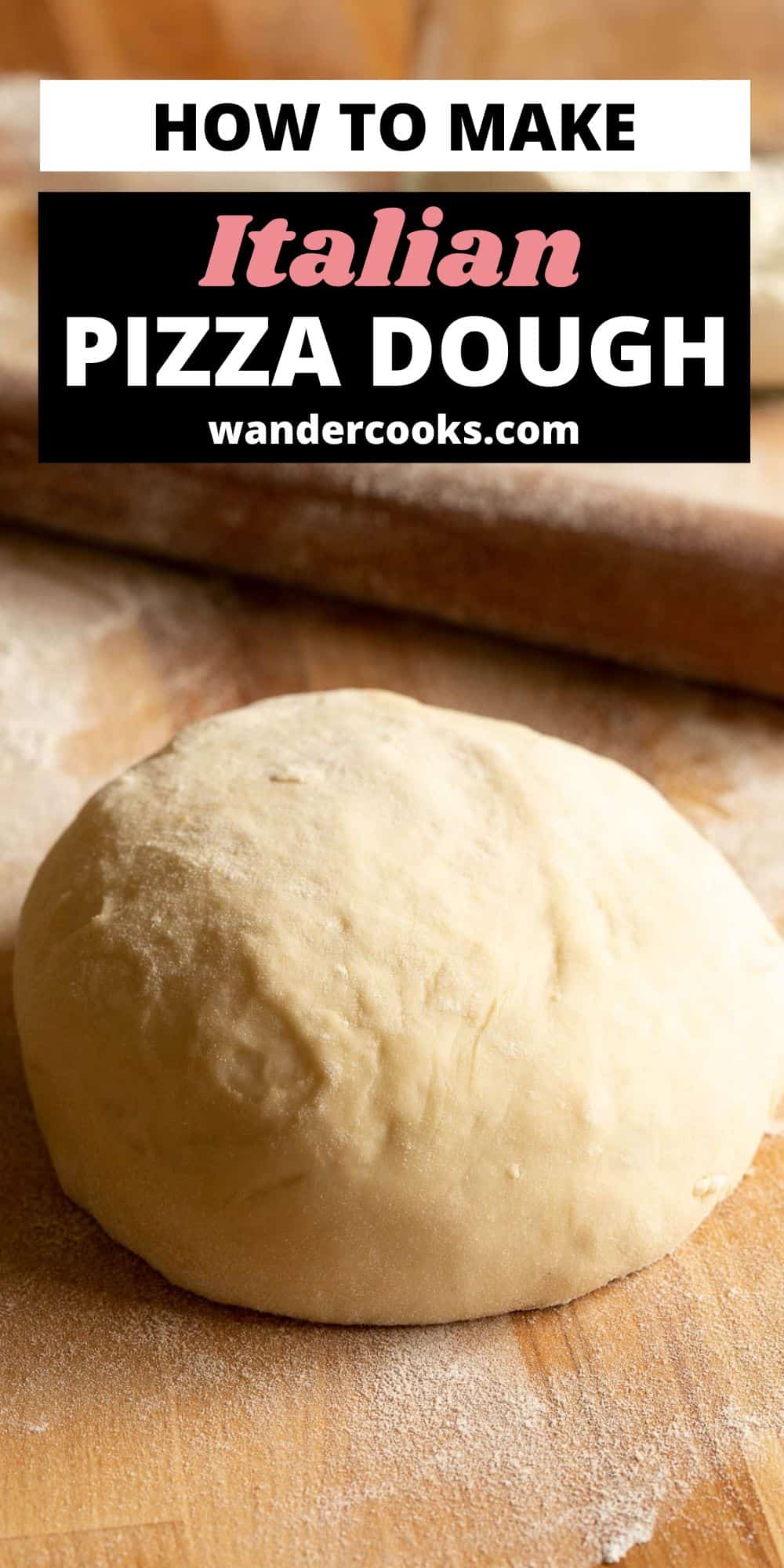

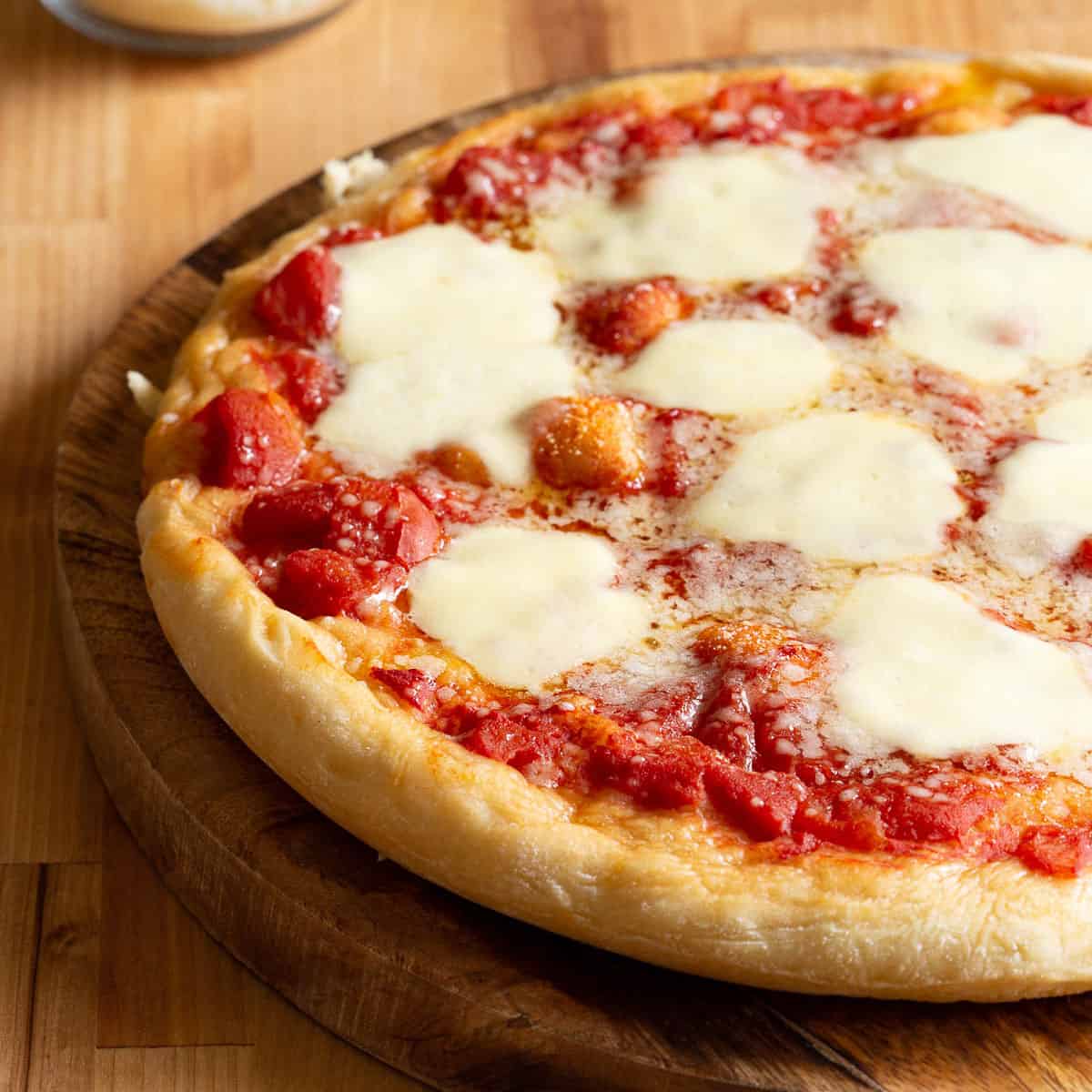



6 Comments
Vivian
08/08/2021 at 11:48 amThis was so tasty….I made it in my cast iron skillet. I preheated the skillet on a burner while I put the toppings on. It was crispy and had a great texture. I only made half the recipe because I wanted to taste it before I made more. This will definitely be my go to crust from now on. Thank you!
Wandercooks
10/08/2021 at 9:46 amSounds wonderful Vivian. Thanks for the feedback!
kim
28/06/2021 at 12:06 amLooks great, and so easy! I would have loved to have seen pics of the cut pie with closeups of the crust both edge and underside to see thickness and texture, as i’m on a mission to find the perfect crust. Oh well, guess I’ll just have to make it! Thanks for the recipe!
Wandercooks
30/06/2021 at 9:16 amHey Kim! Timing with your comment, we just made these again on the weekend too. Hope you enjoyed yours! Thanks for the recommendation re: the crust edge and underside, next batch I’ll take a pic and add it in. 🙂
Catherine
06/02/2021 at 2:41 amHi, I’ve made this dough 4 or 5 times now, and I love it, but I’m curious about the 250 degrees temperature for the oven. It seems low, and I’ve been cooking the pizza at 450, which seems just right, especially to cook vegetable toppings. Could this be a mistake, or is it just me?
Wandercooks
08/02/2021 at 12:14 pmHello! Oh that’s so good to hear! For the oven temps, it’s 250 degrees Celsius as we’re in Australia. So for Fahrenheit, you could crank your oven up to 480 instead of 450 to cook them a little quicker. 🙂 I’ve also updated the recipe to avoid this confusion in the future. Happy cooking!